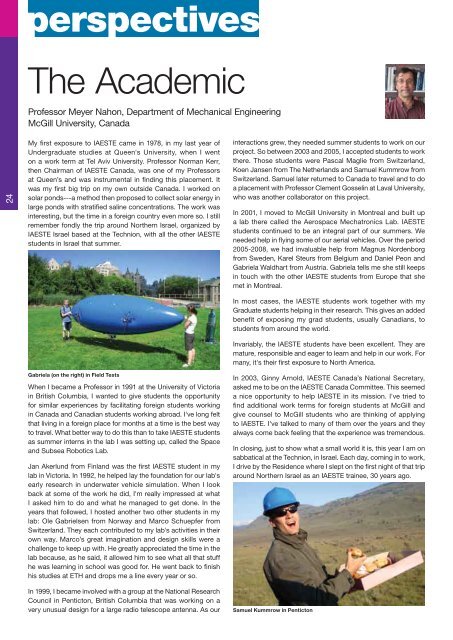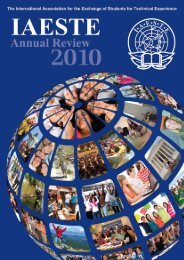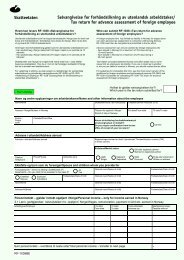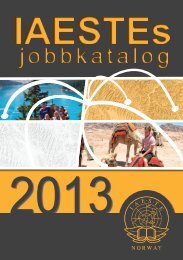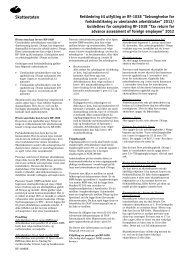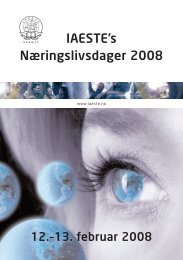View Annual Review - IAESTE
View Annual Review - IAESTE
View Annual Review - IAESTE
You also want an ePaper? Increase the reach of your titles
YUMPU automatically turns print PDFs into web optimized ePapers that Google loves.
perspectives<br />
The Academic<br />
Professor Meyer Nahon, Department of Mechanical Engineering<br />
McGill University, Canada<br />
24<br />
My first exposure to <strong>IAESTE</strong> came in 1978, in my last year of<br />
Undergraduate studies at Queen's University, when I went<br />
on a work term at Tel Aviv University. Professor Norman Kerr,<br />
then Chairman of <strong>IAESTE</strong> Canada, was one of my Professors<br />
at Queen’s and was instrumental in finding this placement. It<br />
was my first big trip on my own outside Canada. I worked on<br />
solar ponds---a method then proposed to collect solar energy in<br />
large ponds with stratified saline concentrations. The work was<br />
interesting, but the time in a foreign country even more so. I still<br />
remember fondly the trip around Northern Israel, organized by<br />
<strong>IAESTE</strong> Israel based at the Technion, with all the other <strong>IAESTE</strong><br />
students in Israel that summer.<br />
interactions grew, they needed summer students to work on our<br />
project. So between 2003 and 2005, I accepted students to work<br />
there. Those students were Pascal Maglie from Switzerland,<br />
Koen Jansen from The Netherlands and Samuel Kummrow from<br />
Switzerland. Samuel later returned to Canada to travel and to do<br />
a placement with Professor Clement Gosselin at Laval University,<br />
who was another collaborator on this project.<br />
In 2001, I moved to McGill University in Montreal and built up<br />
a lab there called the Aerospace Mechatronics Lab. <strong>IAESTE</strong><br />
students continued to be an integral part of our summers. We<br />
needed help in flying some of our aerial vehicles. Over the period<br />
2005-2008, we had invaluable help from Magnus Nordenborg<br />
from Sweden, Karel Steurs from Belgium and Daniel Peon and<br />
Gabriela Waldhart from Austria. Gabriela tells me she still keeps<br />
in touch with the other <strong>IAESTE</strong> students from Europe that she<br />
met in Montreal.<br />
Gabriela (on the right) in Field Tests<br />
When I became a Professor in 1991 at the University of Victoria<br />
in British Columbia, I wanted to give students the opportunity<br />
for similar experiences by facilitating foreign students working<br />
in Canada and Canadian students working abroad. I've long felt<br />
that living in a foreign place for months at a time is the best way<br />
to travel. What better way to do this than to take <strong>IAESTE</strong> students<br />
as summer interns in the lab I was setting up, called the Space<br />
and Subsea Robotics Lab.<br />
Jan Akerlund from Finland was the first <strong>IAESTE</strong> student in my<br />
lab in Victoria. In 1992, he helped lay the foundation for our lab's<br />
early research in underwater vehicle simulation. When I look<br />
back at some of the work he did, I'm really impressed at what<br />
I asked him to do and what he managed to get done. In the<br />
years that followed, I hosted another two other students in my<br />
lab: Ole Gabrielsen from Norway and Marco Schuepfer from<br />
Switzerland. They each contributed to my lab's activities in their<br />
own way. Marco’s great imagination and design skills were a<br />
challenge to keep up with. He greatly appreciated the time in the<br />
lab because, as he said, it allowed him to see what all that stuff<br />
he was learning in school was good for. He went back to finish<br />
his studies at ETH and drops me a line every year or so.<br />
In 1999, I became involved with a group at the National Research<br />
Council in Penticton, British Columbia that was working on a<br />
very unusual design for a large radio telescope antenna. As our<br />
In most cases, the <strong>IAESTE</strong> students work together with my<br />
Graduate students helping in their research. This gives an added<br />
benefit of exposing my grad students, usually Canadians, to<br />
students from around the world.<br />
Invariably, the <strong>IAESTE</strong> students have been excellent. They are<br />
mature, responsible and eager to learn and help in our work. For<br />
many, it's their first exposure to North America.<br />
In 2003, Ginny Arnold, <strong>IAESTE</strong> Canada’s National Secretary,<br />
asked me to be on the <strong>IAESTE</strong> Canada Committee. This seemed<br />
a nice opportunity to help <strong>IAESTE</strong> in its mission. I've tried to<br />
find additional work terms for foreign students at McGill and<br />
give counsel to McGill students who are thinking of applying<br />
to <strong>IAESTE</strong>. I've talked to many of them over the years and they<br />
always come back feeling that the experience was tremendous.<br />
In closing, just to show what a small world it is, this year I am on<br />
sabbatical at the Technion, in Israel. Each day, coming in to work,<br />
I drive by the Residence where I slept on the first night of that trip<br />
around Northern Israel as an <strong>IAESTE</strong> trainee, 30 years ago.<br />
Samuel Kummrow in Penticton


